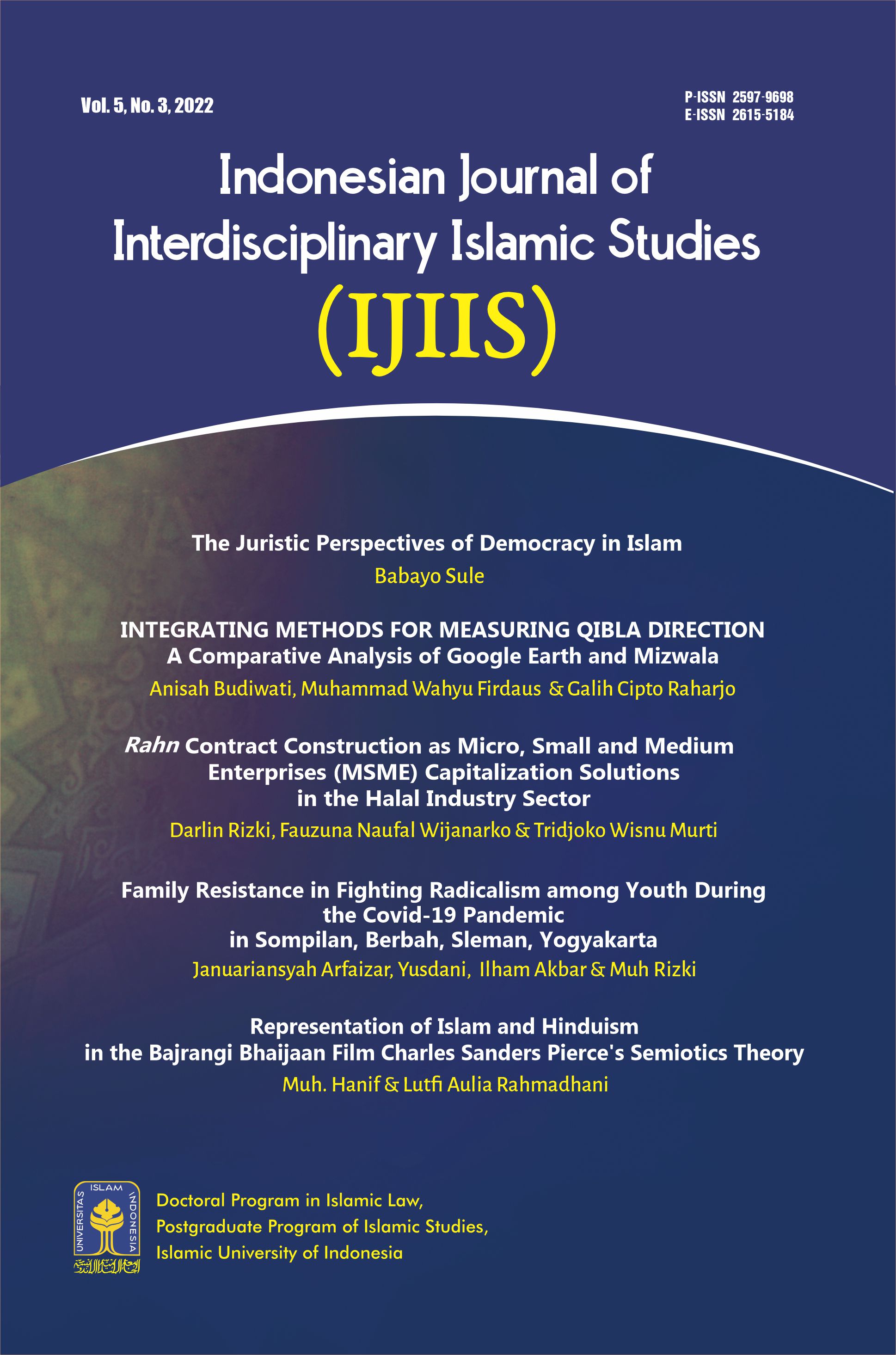Main Article Content
Abstract
In inter-religious relations there are various ways and steps to promote peace. One way is through audio-visual media in the form of films. The Bajrangi Bhaijaan film, a Bollywood production, has many messages that are closely related to the values that carry a message of peace between religious communities. This article attempts to represent how a good deed can be done regardless of religious background. In particular, this article describes the various behaviors of religious people, in this case Islam and Hinduism, which are represented through the roles played by the characters in the film. The method used in this article is a qualitative-descriptive method using Charles Sanders Pierce's semiotic analysis. The article argues that the various attitudes displayed through the characters played in the film about the relationship between Muslims and Hindus in India and with neighboring countries, namely Pakistan, can be an illustration for religious people to live side by side in harmony.
Keywords
Article Details

This work is licensed under a Creative Commons Attribution-ShareAlike 4.0 International License.
References
- Alamsyah, Femi Fauziah. “Representasi, Ideologi dan Rekonstruksi Media.” Al-I’lam: Jurnal Komunikasi dan Penyiaran Islam 3, no. 2 (June 30, 2020): 92–99. https://doi.org/10.31764/jail.v3i2.2540.
- Ariffudin, and Andi Fikra Pratiwi. “Film Sebagai Media Dakwah Islam.” Aqlam: Journal of Islam and Plurality 2, no. 2 (February 12, 2017). https://doi.org/10.30984/ajip.v2i2.523.
- Asir, Ahmad. “Agama Dan Fungsinya Dalam Kehidupan Umat Manusia.” Al-Ulum Jurnal Pemikiran Dan Penelitian Ke Islaman 1, no. 1 (February 7, 2014): 50–58. https://doi.org/10.31102/alulum.1.1.2014.50-58.
- Asri, Rahman. “Membaca Film Sebagai Sebuah Teks: Analisis Isi Film ‘Nanti Kita Cerita Tentang Hari Ini (NKCTHI).’” Jurnal Al Azhar Indonesia Seri Ilmu Sosial 1, no. 2 (August 29, 2020): 74–86. https://doi.org/10.36722/jaiss.v1i2.462.
- Hamali, Syaiful. “Agama Dalam Perspektif Sosiologis.” Al-Adyan: Jurnal Studi Lintas Agama 12, no. 2 (December 30, 2017): 223–44. https://doi.org/10.24042/ajsla.v12i2.2111.
- Junadi, Mahbub. “Manusia Dalam Berbagai Perspektif.” Dar El-Ilmi: Jurnal Studi Keagamaan, Pendidikan Dan Humaniora 4, no. 1 (April 17, 2017): 35–55. https://doi.org/10.52166/dar.
- Lakonawa, Petrus. “Agama Dan Pembentukan Cara Pandang Serta Perilaku Hidup Masyarakat.” Humaniora 4, no. 2 (October 31, 2013): 790–99. https://doi.org/10.21512/humaniora.v4i2.3507.
- Lestari, Gina. “Bhinnekha Tunggal Ika: Khasanah Multikultural Inonesia Di Tengah Kehidupan Sara.” Jurnal Ilmiah Pendidikan Pancasila Dan Kewarganegaraan 28, no. 1 (June 27, 2015). https://doi.org/10.17977/jppkn.v28i1.5437.
- Miskahuddin, Miskahuddin. “Konsep Agama Menurut Al-Qur’an.” Jurnal Ilmiah Al-Mu’ashirah: Media Kajian Al-Qur’an dan Al-Hadits Multi Perspektif 14, no. 1 (November 24, 2017): 64–77. https://doi.org/10.22373/jim.v14i1.2240.
- Mulyadi. “Agama Dan Pengaruhnya Dalam Kehidupan.” Tarbiyah Al-Awlad: Jurnal Kependidikan Islam Tingkat Dasar 7, no. 2 (2016). https://doi.org/10.15548/alawlad.v7i2.424.
- Rahman, M. Syaiful. “Islam Dan Pluralisme.” FIKRAH 2, no. 2 (December 28, 2014). https://doi.org/10.21043/fikrah.v2i2.666.
- Ulum, Raudatul. “Institusi Minoritas Dan Struktur Sosial Di Dunia.” Harmoni 17, no. 1 (June 30, 2018): 7–26. https://doi.org/10.32488/harmoni.v17i1.289.
References
Alamsyah, Femi Fauziah. “Representasi, Ideologi dan Rekonstruksi Media.” Al-I’lam: Jurnal Komunikasi dan Penyiaran Islam 3, no. 2 (June 30, 2020): 92–99. https://doi.org/10.31764/jail.v3i2.2540.
Ariffudin, and Andi Fikra Pratiwi. “Film Sebagai Media Dakwah Islam.” Aqlam: Journal of Islam and Plurality 2, no. 2 (February 12, 2017). https://doi.org/10.30984/ajip.v2i2.523.
Asir, Ahmad. “Agama Dan Fungsinya Dalam Kehidupan Umat Manusia.” Al-Ulum Jurnal Pemikiran Dan Penelitian Ke Islaman 1, no. 1 (February 7, 2014): 50–58. https://doi.org/10.31102/alulum.1.1.2014.50-58.
Asri, Rahman. “Membaca Film Sebagai Sebuah Teks: Analisis Isi Film ‘Nanti Kita Cerita Tentang Hari Ini (NKCTHI).’” Jurnal Al Azhar Indonesia Seri Ilmu Sosial 1, no. 2 (August 29, 2020): 74–86. https://doi.org/10.36722/jaiss.v1i2.462.
Hamali, Syaiful. “Agama Dalam Perspektif Sosiologis.” Al-Adyan: Jurnal Studi Lintas Agama 12, no. 2 (December 30, 2017): 223–44. https://doi.org/10.24042/ajsla.v12i2.2111.
Junadi, Mahbub. “Manusia Dalam Berbagai Perspektif.” Dar El-Ilmi: Jurnal Studi Keagamaan, Pendidikan Dan Humaniora 4, no. 1 (April 17, 2017): 35–55. https://doi.org/10.52166/dar.
Lakonawa, Petrus. “Agama Dan Pembentukan Cara Pandang Serta Perilaku Hidup Masyarakat.” Humaniora 4, no. 2 (October 31, 2013): 790–99. https://doi.org/10.21512/humaniora.v4i2.3507.
Lestari, Gina. “Bhinnekha Tunggal Ika: Khasanah Multikultural Inonesia Di Tengah Kehidupan Sara.” Jurnal Ilmiah Pendidikan Pancasila Dan Kewarganegaraan 28, no. 1 (June 27, 2015). https://doi.org/10.17977/jppkn.v28i1.5437.
Miskahuddin, Miskahuddin. “Konsep Agama Menurut Al-Qur’an.” Jurnal Ilmiah Al-Mu’ashirah: Media Kajian Al-Qur’an dan Al-Hadits Multi Perspektif 14, no. 1 (November 24, 2017): 64–77. https://doi.org/10.22373/jim.v14i1.2240.
Mulyadi. “Agama Dan Pengaruhnya Dalam Kehidupan.” Tarbiyah Al-Awlad: Jurnal Kependidikan Islam Tingkat Dasar 7, no. 2 (2016). https://doi.org/10.15548/alawlad.v7i2.424.
Rahman, M. Syaiful. “Islam Dan Pluralisme.” FIKRAH 2, no. 2 (December 28, 2014). https://doi.org/10.21043/fikrah.v2i2.666.
Ulum, Raudatul. “Institusi Minoritas Dan Struktur Sosial Di Dunia.” Harmoni 17, no. 1 (June 30, 2018): 7–26. https://doi.org/10.32488/harmoni.v17i1.289.
